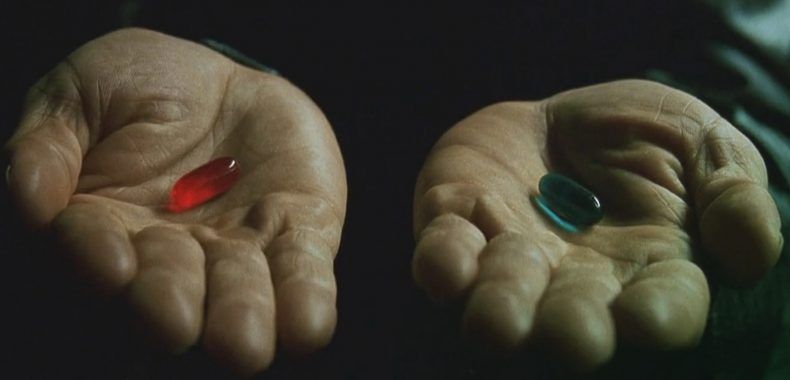
Take the red pill
Back to /blog/newsby
Georg C. F. Greve

Wed Apr 03 2019
Would you have taken the blue or the red pill? The steak tastes real. Most of the people you interact with are real. Your emotions are certainly real. It is not surprising that so many people choose the blue pill of Facebook every day. When The Matrix movie was released, Google was just getting started as a search engine and Facebook was not to exist for some years. But from today’s perspective the film offers a surprisingly fitting analogy for today’s social networks.
In The Matrix, humanity is kept in a virtual reality that keeps them busy, distracted and emotionally involved. People laugh, like, love, hate and communicate while they are being drained of their body heat. As a physicist, this last part never made sense to me. There are easier ways to generate heat. But some things are so precious they would warrant enormous efforts. Control over human attention, for instance. Measured in preciously scarce life span, it is the prerequisite for manipulating human behaviour, be it shopping or voting.
To keep us involved, social media must evoke emotional responses. Love, hate and our own ego provide some of the strongest triggers possible. Which is why Jaron Lanier argues people should delete their accounts right away:
"Every example I know of where somebody has done research on those who have deleted their accounts has found that, on the whole, almost everyone feels better, healthier, more connected, better informed, they feel they have more free time, and they’re more fulfilled.”
It seems that calling such platforms social media is one of the biggest frame jobs ever pulled off. But is deleting them the answer? Or is it simply asking people to go back to the cave? Humans crave connectedness. We are at our best when we come together and have an innate desire to form communities. There is no going back to a world where people do not know about the possibilities of a world connected.
But if the current social networks are more like social spider webs in which our every twitching feeds the enormous spider in the middle, be it Facebook, Google, Twitter, Weibo or Baidu, what would be the alternative? As human beings, we need authority over ourselves, the ability to decide. We can only truly be social where we are safe. The safest space most of us have in the physical world is our home, even if just for a night. There is no equivalent on-line. In fact, the digital world has become just as real for us as the physical world. Both are increasingly inseparable. And the on-line world reaches us even when we are at home, with the door closed and the curtains drawn.
If we want a human social network, we first need a home for our digital self. A place that safeguards our identity and data and that is under our own control. From there we can weave the social fabric that is the basis of our society. By interaction with others, and on our own terms. Such a social fabric would be no less connected. But it would be a far more powerful experience because it does not need to manipulate us, nor put us under constant surveillance. We can use this social fabric to communicate, make contracts, establish friendships, even make financial transactions.
To succeed, such a social fabric must have an extremely low barrier to entry. It cannot exclude people for lack of technical expertise, so it must offer user experience that is intuitive and natural. It must be built by companies that align with the principles of our social fabric, because only professional development can tackle such complex issues in a lasting way. Unlike the surveillance industry, the social fabric would have equitable interactions between people and companies as its economic driver. And it rewards its developers and operators by means of a revenue share between the companies building and maintaining that social fabric.
At a technical level, the social fabric must be open and inclusive. People and companies should be able to re-use it and adapt it to their own needs, adding functionality, using it to improve their own services and products. So it must be fully Open Source and built in a way that encourages participation. Not to mention it should be using state of the art security design, encryption and protect against the most common issues experienced today. Among other things that means no more user names and passwords, and no security questions to restore access.
You might think this sounds like science fiction. Wishful thinking of a world that is so very different of what we experience each day that it will take forever for this vision to become reality. But you could be using it this year. We started Vereign in 2017 to pursue this idea, and spent all of 2018 to grow a small team, work on the concepts, try out ideas, and build a prototype. Right now we’re working on completing our initial set of features to allow the social fabric to become reality.
Vereign is working to complete the first version of this social fabric. For the start we decided to focus on an initial set of features that will make it useful to every person and company right away. E-mail is useful, ubiquitous, and broken. So we decided it would be our first use case, followed by documents — the medium of all contracts. But once that fabric is operational it can secure the identity of chats and voice calls, protect financial interactions, and become the basis for a social network that is truly that.
So in a way, Vereign is working on the red pill. And unlike the cinematic version, ours is entirely pain free. All you need to do is sign up at app.vereign.com to try the prototype, which takes all of 30 seconds to complete. Then you could join our forum at community.vereign.com and share your vision of the social fabric with us. And finally, please help us spread the word. Because like all good things, it multiplies when shared.